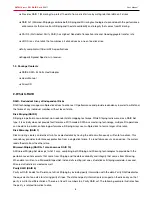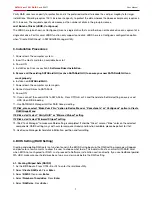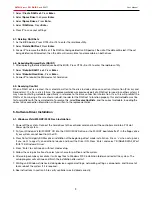
SATAII 4 port PCI RAID Card
RC217 User Manual
6
Provides RAID 1 (Mirroring) to protect the data from a disk failure by writing identical data on 2 drives.
RAID 0+1 (Mirrored-Stripping) combine both Striping and Mirroring technologies to provide both the performance
enhancements that come from Striping and the data availability and integrity that comes from Mirroring.
RAID 5 (Distributed Parity RAID) has Highest Read data transaction rate and Good aggregate transfer rate
JBOD is a virtual disk that combines all disk drives as one entire disk drive
Fully compliant with Serial ATA specifications
Supports Spread Spectrum in receiver.
1.2. Package Contents
RAID5 SATA II 4Ports Host Adapter
Users Manual
Driver CD
2. What Is RAID
RAID - Redundant Array of Independent Disks
RAID technology manages multiple disk drives to enhance I/O performance and provide redundancy in order to withstand
the failure of any individual member, without loss of data.
Disk Striping (RAID 0)
Striping is a performance-oriented, non-redundant data mapping technique. While Striping is discussed as a RAID Set
type, it is actually does not provide fault tolerance. With modern SATA bus mastering technology, multiple I/O operations
can be done in parallel, enhancing performance. Striping arrays use multiple disks to form a larger virtual disk.
Disk Mirroring (RAID 1)
Disk mirroring creates an identical twin for a selected disk by having the data simultaneously written to two disks. This
redundancy provides instantaneous protection from a single disk failure. If a read failure occurs on one drive, the system
reads the data from the other drive.
Mirrored-Striping (RAID 0+1 also known as RAID 10)
A Mirrored-Striping Set does just what it says, combining both Striping and Mirroring technologies to provide both the
performance enhancements that come from Striping and the data availability and integrity that comes from Mirroring.
When data is written to a Mirrored-Striped Set, instead of creating just one virtual disk as Striping would do, a second,
Mirrored virtual disk is created as well.
Parity RAID (RAID 5)
Parity or RAID 5 adds fault tolerance to Disk Striping by including parity information with the data. Parity RAID dedicates
the equivalent of one disk for storing parity stripes. The data and parity information is arranged on the disk array so that
parity is written to different disks. There are at least 3 members to a Parity RAID set. The following example illustrates how
the parity is rotated from disk to disk.




























